Travel E-Logs: Amazon Rain Forest
Travel E-Logs #3: Baños - Where the Rain Forest Begins
Dear Students:
Lilia and I are now
in Limoncocha, not far from the Napo River in the Amazon Rain Forest
region of Ecuador. [In Ecuador, the Amazon region is known as el oriente
(‘the East’), because it is the easternmost region of the country.
La 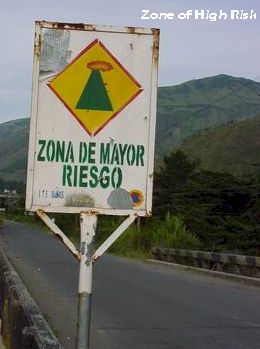 costa
(the coast) is in the west and la sierra (the mountains) in the
center. Las islas galapagos (the Galapagos Islands) are further west
in el oceano pacifico (the Pacific Ocean).] The Napo is a huge river,
two to three hundred yards across near Limoncocha. In a canoe, floating down
it, you might wonder, ‘Where does all this water come from?’ To
find the answer to that question, Lilia and I started our project by visiting
the town of Baños on the edge of the Andes, just before the mountains
roll down into the vast tree-filled plane that is la selva amazonica,
the Amazon Rain Forest.
costa
(the coast) is in the west and la sierra (the mountains) in the
center. Las islas galapagos (the Galapagos Islands) are further west
in el oceano pacifico (the Pacific Ocean).] The Napo is a huge river,
two to three hundred yards across near Limoncocha. In a canoe, floating down
it, you might wonder, ‘Where does all this water come from?’ To
find the answer to that question, Lilia and I started our project by visiting
the town of Baños on the edge of the Andes, just before the mountains
roll down into the vast tree-filled plane that is la selva amazonica,
the Amazon Rain Forest.
Baños de la Agua Santa
Baños, in Spanish, means, ‘Baths.’ The full name for the town is Baños de la Agua Santa – ‘Baths of the Holy Water.’ For hundreds of years, many people in Ecuador have believed that the spring waters of Baños are holy and that they cure people who have injuries, disabilities or sicknesses. People from all parts of Ecuador flock to Baños when they have vacation. They visit Baños to bathe in its pure mineral waters and enjoy the beauty of the mountains that surround the town, mountains from which the waters come.
Some of the water in Baños is not only considered holy, its HOT -- heated by another tourist attraction, Baños’ resident active volcano, Tungurahua. Water from Baños’ hot thermal springs reaches 54 Celsius. That’s too hot for humans, so the water is cooled to a steamy 37 for the baths – and eucalyptus leaves are added to give the water a pleasant smell and an additional medicinal value. Twice a day, the baths are drained, cleaned and refilled so more people can enjoy them.
Las Cascadas
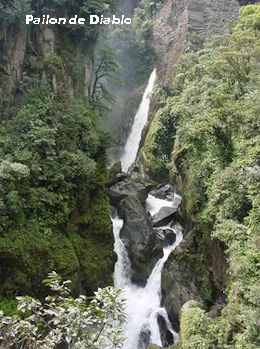 There
are still other famous waters in Baños, waters that come tumbling down
mountainsides in strikingly beautiful cascadas, or, in English, waterfalls.
There’s a route around the town of Baños, winding through the
mountain valleys, known as La Avenida de las Cascadas – The Avenue
of the Waterfalls. The largest and best known waterfall in the area is called
El Pailon del Diablo – The Devil’s Pot. People say you
can see the devil’s face in the rocks below the falls. Can you see it
(in the attached photo)? For us it was hard to picture until we saw an artist’s
depiction of the stony face on a mural. Can you see the ‘pot?’
(We guessed that the pot was the enclosed area in which the water fell, surrounded
on three sides by rock.)
There
are still other famous waters in Baños, waters that come tumbling down
mountainsides in strikingly beautiful cascadas, or, in English, waterfalls.
There’s a route around the town of Baños, winding through the
mountain valleys, known as La Avenida de las Cascadas – The Avenue
of the Waterfalls. The largest and best known waterfall in the area is called
El Pailon del Diablo – The Devil’s Pot. People say you
can see the devil’s face in the rocks below the falls. Can you see it
(in the attached photo)? For us it was hard to picture until we saw an artist’s
depiction of the stony face on a mural. Can you see the ‘pot?’
(We guessed that the pot was the enclosed area in which the water fell, surrounded
on three sides by rock.)
Other nearby waterfalls are called La Cascada de la Vida (The Waterfall of Life), El Manto de la Novia (The Veil of the Bride, pictured), La Cabellera de la Virgen (The Virgin Mary’s Head of Hair), Los Tobaganes Naguasa (The Naguasa Toboggans), Ulba, Bascun, Agoyan (pictured), Chamana, Ines Maria, San Jorge and Santo Domingo.
Mountain Waters and Rain Forest Rivers
So the water of Baños (along with the volcano that heats some of that water) is what makes the town so famous. And water is why we went to Baños – water and gravity. You see, water can only travel, thanks to gravity (unless some other force works on it), in one direction – down! All the waters of Baños (after falling as rain) flow down the mountains – as streams, springs and waterfalls – into el Rio Pastaza, the Pastaza River, a large fast-flowing river that rushes through the valley of Baños. About 40 miles downriver from Baños, the mountains yield to the rain forest plane and the Pastaza begins to flow more slowly. It winds its way out of Ecuador and into Peru where it joins the Marañon River which later flows into the Amazon River. From there, the waters that started flowing in the mountains around Baños (along with waters from many other mountain regions – and all of the rain drained by the Amazon’s upstream tributaries) travel down the wide snake-like Amazon River all the way across the continent and empty into el oceano atlantico, the Atlantic Ocean.
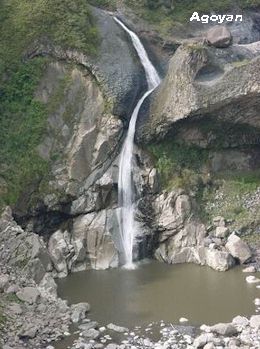 Beautiful
but Dangerous
Beautiful
but Dangerous
Baños is considered one of the most beautiful places in the world. But, it’s also dangerous! High above all that beauty is a live, smoking volcano, Tungurahua. As you drive into Baños, you see a sign that says Bienvenidos a Baños de la Agua Santa (‘Welcome to the Baths of the Holy Water’). But, a short distance later, there’s another sign that has a picture of a volcano on it and says, Zona de Alta Riesgo (High Risk Region). Five years ago, the Ecuadorian government evacuated the hole town of Baños for fear that Tungurahua would erupt, sending streams of molten lava through the valley below. All of the people had to go live in other towns, like Puyo in the rain forest or Ambato in the highlands – for one whole year! Tungurahua rumbled and huffed and puffed – but never blew. Finally, four years ago on January 4th, the people were allowed to go back to their homes. Now, on the anniversary of that date each year, the town holds a fiesta to celebrate their return to Baños.
And Tungurahua is till rumbling and huffing and puffing. On clear nights, you can even see red lava sputtering and flashing above its caldera. On clear days, you can see a constant cloud of smoke and ash looming above mountain. It reminds the people that, while they have reason to celebrate and enjoy their town, they also must remain cautious and ready to evacuate again at any moment.
School Visit
While in Baños,
Lilia and I visited a school called La Escuela Doctor Misael Acostis Solis.
We showed the students there videos featuring students in North America and
Africa. Then, with a group of eight fourth, fifth, sixth and seventh 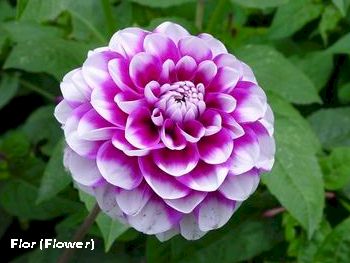 grade
students, we crossed the Pastaza River, climbed one of the mountains that
overlooks Baños and a made a video showing how the water from that
mountain flows down into the Pastaza and out into the rain forest.
The students at the school also drew pictures about Baños for an art
exchange they will complete with their partner classes in the U.S.
grade
students, we crossed the Pastaza River, climbed one of the mountains that
overlooks Baños and a made a video showing how the water from that
mountain flows down into the Pastaza and out into the rain forest.
The students at the school also drew pictures about Baños for an art
exchange they will complete with their partner classes in the U.S.
Trip to Limoncocha
Last Wednesday, after visiting the school, Lilia and I took an overnight bus that followed a road along the Pastaza River. It wound down out of the mountains into the Amazon Rain Forest to a town called Puyo, then veered north away from the Pastaza towards a larger rain forest town called Tena. In Tena, we crossed another large tributary of the Amazon River, el Rio Napo, the Napo River. From Tena, you could take a ten hour canoe ride down the Napo River all the way to Limoncocha, but we went by road.
Like the Pastaza River, the Napo is formed by thousands of small mountain streams and flows from the mountains into the rain forest, out of Ecuador, into Peru, and eventually joins with the Amazon River.
Guess Who
Here’s a poem I have written about a rain forest animal. The first part contains several paradoxes, but by the end I’m sure you’ll figure it out. We’ll include the answer in the next report.
HOME SWEET HAIRY HOME
Home
to many, I live in a tree
Clinging to branches as my tenants cling to me
I'm trunk-grey but look leaf-green
For my coated coat renders me unseen
I'm hooked on limbs and hooked on leaves
Dangling quite comfortably in my canopy trapeze
Upside down, I'm never found on the ground
Quite polite, I'm a slightly odd sight
Inclined to eschew the jungle's commotion
I find my amusement in humble slow motion
Lair of the beetle and den of the moth
I'm none other than a three-toed ____________.
You can find lots more guess who rain forest animal poems – and see photos of the animals -- here.
Questions
Classes participating
in our project can send questions for rain forest students. We’ll be
sending the replies after we visit more schools here in the Amazon. In the
meantime, here are questions and answers from last years report.
These answers were given by a group of 40 students in grades 1-6 at the Amazon
River Elementary School in Limoncocha.
Are you afraid of
snakes? Of 40, 39 said 'yes' and 1 said 'no' (but most
didn't believe the one who said no).
Has anyone in your class been to Quito (the capital of Ecuador)? Yes,
10 of 40.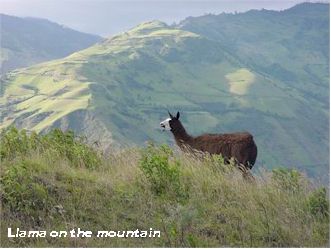
Do you have turtles in your lakes? Yes, black turtles
and small ones that we call charapas. We like to eat charapa lulu (turtle
eggs).
Do you speak a bit of English? A few of us speak a bit.
How do you cook your food? In boiling water, fried,
smoked, grilled or in maito (rolled up in a special leaf and cooked on an
open fire).
Do snakes get in your houses? 17 of 40 have had snakes
in their homes (as far as they know).
Do you have VCR's and videos? 10 of 40 do.
Do you have video games? No. A few students in the high
school do.
Do you have telephones in your homes? 3 of 40 students
have cell phones in their homes.
What do you use to fish? Mostly fishing poles with lines
and hooks, and fishing nets. Sometimes adults use spears. When we fish with
nets, we also use long poles to place the nets on. We usually take a machete
with us when we go fishing. We either go along the lakeshore or we go with
a canoe and an oar. For bait we use worms, grubs, ripe plantains, snails,
meat (for piranha) or pieces of fish. We use a shigra (a string bag) to carry
the fish we catch.
What kinds of toys do you play with? Dolls, cars, marbles,
airplanes, stuffed animals and balls are the most popular.
What kinds of chores do you do? Mostly collecting water,
working with the machete or harvesting crops in the garden/farm, watching
younger brothers and sisters, making chicha or other food, fishing, hunting,
sweeping the floor, making a fire, washing and hanging clothes, washing dishes
and collecting fruit from trees.
Is it hard to live in the rain forest? No, it's not
hard. We like it.
Is it cool and fun to live in the rain forest? It's
chevere (cool) but not frio (cool) and we think it's very fun to live here.
Do you sleep on the floor and does that hurt? We sleep
on beds.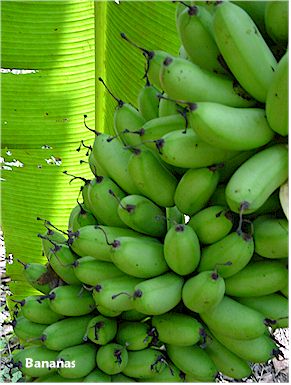
Have you ever heard of Chicago? No, we hadn't. But,
now we have!
We know in Panama they use coconuts for bowls. What kind of bowls do you use
in the rain forest? What are your bowls made out of?
We mostly have bowls made of plastic and glass that we buy at the market or
in a larger town about an hour away. Sometimes we use bowls made from a large
fruit that comes from a tree called a calabash tree. We clean out the fruit,
which is not edible, and cut the hard outer shell in half to make the bowls.
Sometimes we carve designs in the bowls to decorate them. Sometimes we also
make bowls out of clay that we get from nearby rivers.
My classmates and I looked in a book and we saw people with paint on their
bodies. Why do they put paint on their bodies? Does everyone in the rain forest
do this? Most people who live around our part of the
rain forest do not put paint on their bodies. But, almost all of the different
rain forest nationalities that live in our region used to paint their bodies.
We mainly used to use a red dye from the seeds of the achiote flower, but
sometimes we would use clay and other natural dyes or colors. People put dye
on their bodies for different reasons: for decoration, to protect them from
spirits, to frighten their enemies, for good luck (when hunting, fishing or
planting crops) and to repel insects. Nowadays, most people in our area only
paint their bodies when we have a festival or a dance that celebrates our
traditional culture. We have learned that in other parts of the Amazon, some
people still paint their bodies.
My classmates and I looked in a book and we saw land that was so dry it was
full of cracks. How does the land get so dry when there is so much rain? We
don't have any land near us with cracks, but each year there is usually a
period of time when it doesn't rain for a while. This year, it has hardly
rained since New Year's Day. It just began raining again this week. During
this time, the sun can get very hot and the roads get very dusty. A lot of
people catch colds during this time of year.(Note from Paul and Lilia: Later
on this year, we did see land full of cracks close to the community of Cuyabeno
because it hadn't rained for over a month.)
What language do you speak in the rain forest? We speak
Quichua and Spanish, but other nationalities have their own languages. In
our region, Shuar, Huaorani and Secoya are also spoken.
Is it dangerous in the rain forest? There are dangers,
but it's not very dangerous day to day.
Do you have an alphabet like we do? Does your alphabet have 26 letters? Quichua
was a spoken language until recently. Spanish has 28 letters.
That’s All for Now
That’s all for this report. Hasta pronto!
Paul and Lilia
=====================================
| E-Travel Log #1: Introduction to the Project and the Adventure Team |
| E-Travel Log #2: Quito, Banos and Flashbacks of Christmas Celebrations in Limoncocha |
| E-Travel Log #3: Banos - Where the Rain Forest Begins |
| E-Travel Log #4: Limoncocha - A Quichua Community |
| E-Travel Log #5: Limoncocha and Communities Around - Traditions and Cultures |
| E-Travel Log #6: Getting Ready to Leave for Cuyabeno |
| E-Travel Log #7: Rain Forest Animals |
| E-Travel Log #8: Rain Forest Stories and the Mysterious Black Lake |
| E-Travel Log #9: Trip to Playas de Cuyabeno |
| E-Travel Log #10: Trip to San Pablo - a Secoya Community |
